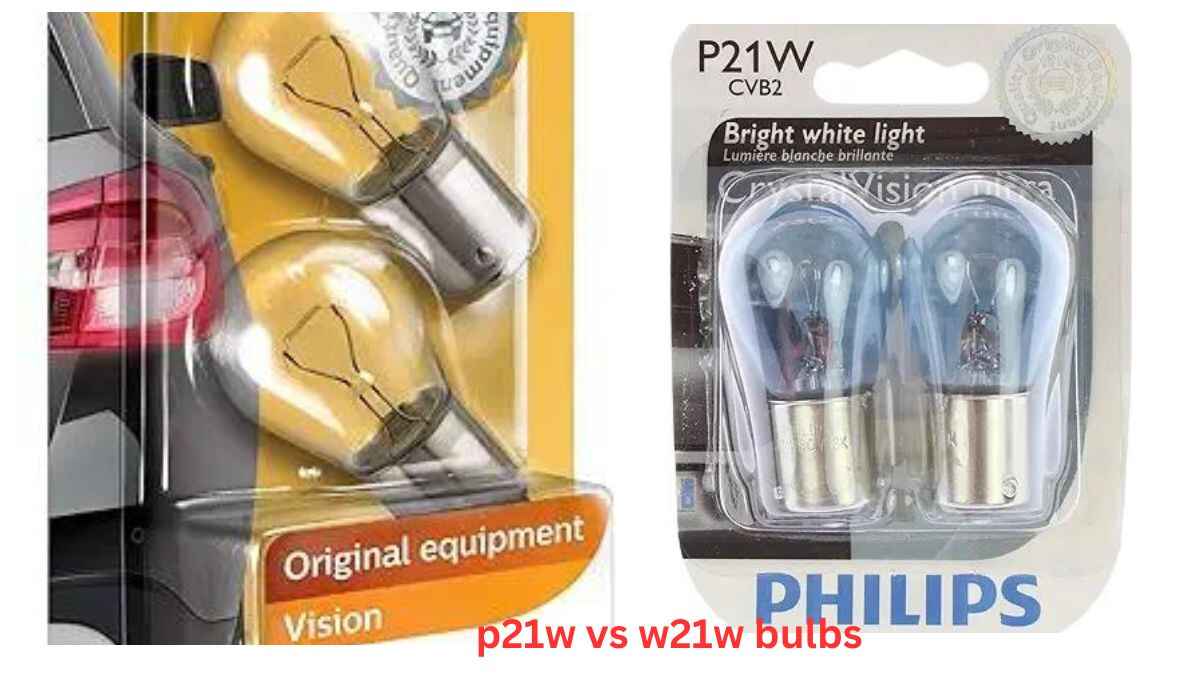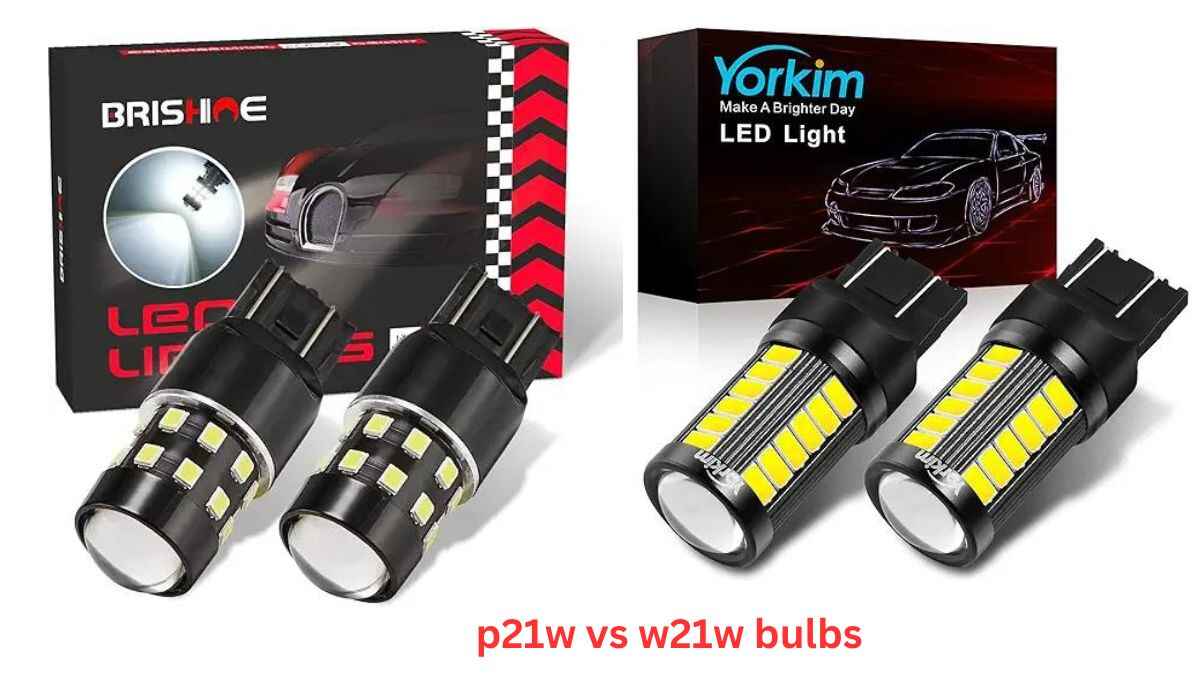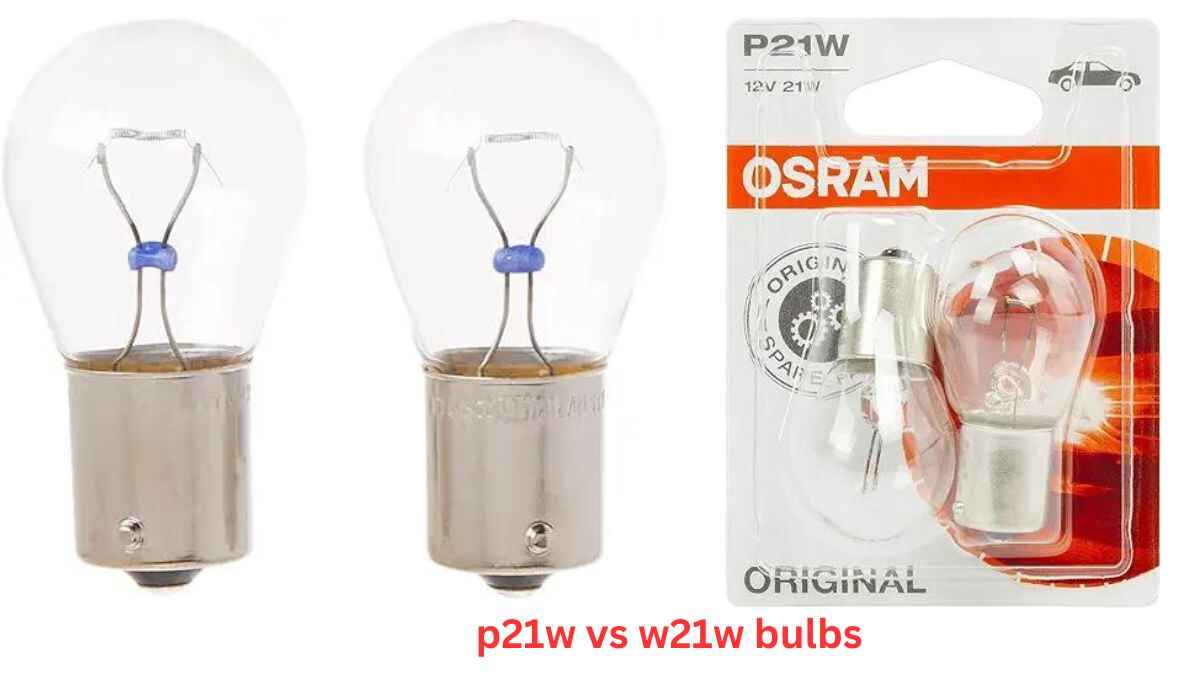When it comes to car bulbs, understanding the difference between P21W vs W21W bulbs can be crucial for ensuring safety and optimal performance. In this article, we will dive deep into the meanings, uses, and benefits of P21W and W21W bulbs. By the end, you’ll have all the information you need to make an informed choice for your vehicle’s lighting needs.

P21W Bulb Meaning
One of the most popular varieties of car light bulbs is the P21W model. They are frequently seen in indicator lights, brake lights, and tail lights. P21W’s “P” stands for “parallel,” referring to how the pins are positioned. These bulbs are usually easy to install and secure because of their bayonet base.
Key Features of P21W Bulbs
1. Brightness: P21W bulbs are known for their bright illumination, making them ideal for signaling and ensuring visibility on the road.
2. Voltage and Wattage: They usually operate at 12 volts and consume 21 watts of power.
3. Lifespan: These bulbs have a decent lifespan but may need replacement more frequently than LED options.
4. Compatibility: They are compatible with a wide range of vehicles, both older and newer models.
Pros and Cons of P21W Bulbs
Pros:
- Bright Light Output: Enhances visibility for safety.
- Easy Installation: Bayonet base design for quick replacement.
- Affordable: Generally cheaper than LED alternatives.
Cons:
- Higher Power Consumption: Uses more energy compared to LEDs.
- Shorter Lifespan: Requires more frequent replacements.
Common Uses of P21W Bulbs
P21W bulbs are versatile and can be used in various lighting applications in a vehicle:
- Brake Lights: Their brightness makes them perfect for indicating braking.
- Tail Lights: Ensures your vehicle is visible from behind.
- Indicator Lights: Used for turn signals and hazard lights.
W21W Bulbs Meaning
W21W bulbs are another type of automotive light bulb, often found in similar applications as P21W bulbs but with some differences in design and functionality. The “W” in W21W stands for “wedge,” indicating the type of base they have.

Key Features of W21W Bulbs
1. Brightness: W21W bulbs also provide bright illumination, suitable for various signaling purposes.
2. Voltage and Wattage: These bulbs operate at 12 volts and consume 21 watts of power.
3. Lifespan: Similar to P21W bulbs, they have a moderate lifespan.
4. Compatibility: Widely compatible with many vehicle models.
Pros and Cons of W21W Bulbs
Pros:
- Bright Light Output: Effective for signaling and visibility.
- Compact Design: Wedge base allows for more compact installations.
- Affordable: Cost-effective solution for vehicle lighting.
Cons:
- Higher Power Consumption: Similar to P21W, they consume more power than LEDs.
- Shorter Lifespan: Needs replacement relatively frequently.
Common Uses of W21W Bulbs
W21W bulbs are also used in a variety of vehicle lighting applications:
- Brake Lights: Provides clear signaling when braking.
- Tail Lights: Ensures the vehicle is visible from behind.
- Indicator Lights: Used for turn signals and hazard lights.
P21W vs W21W: Which is Better?
When deciding between P21W vs W21W bulbs, it’s important to consider your specific needs and vehicle requirements. Both bulbs offer bright illumination and are commonly used in similar applications, but there are some differences that might influence your decision.
Installation and Compatibility
P21W bulbs have a bayonet base, making them easy to install and remove. They are widely compatible with many vehicle models, especially older ones. On the other hand, W21W bulbs have a wedge base, which can be more compact and fit into tighter spaces. This can be advantageous for modern vehicles with more intricate light housings.
Brightness and Visibility
Both P21W and W21W bulbs offer similar brightness levels, making them suitable for brake lights, tail lights, and indicators. The choice between the two may come down to the design of your vehicle’s light fixtures and personal preference.

Power Consumption and Lifespan
Both P21W and W21W bulbs consume 21 watts of power and operate at 12 volts. They have comparable lifespans, meaning you may need to replace them regularly. If you are looking for a more energy-efficient and long-lasting solution, consider upgrading to LED bulbs.
Cost
P21W and W21W bulbs are generally affordable, making them a cost-effective choice for vehicle lighting. However, they do require more frequent replacements compared to LED alternatives, which could add up over time.
Encouraging the Purchase: Why Upgrade to LED Bulbs?
While P21W and W21W bulbs are effective and affordable, upgrading to LED bulbs can provide several benefits. LEDs offer lower power consumption, longer lifespans, and even brighter illumination. They are also available in both bayonet and wedge base designs, ensuring compatibility with most vehicles.
Benefits of LED Bulbs
1. Energy Efficiency: LEDs consume significantly less power than traditional bulbs, reducing the strain on your vehicle’s electrical system.
2. Longevity: LED bulbs have much longer lifespans, often lasting tens of thousands of hours.
3. Brightness: LEDs provide brighter and more consistent illumination, improving visibility and safety.
4. Durability: LEDs are more resistant to shock and vibration, making them ideal for vehicle applications.
Top LED Bulbs to Consider
Here are some top-rated list of LED bulbs to consider for upgrading your vehicle’s lighting:
- Philips X-tremeUltinon LED: Known for its exceptional brightness and long lifespan.
- SYLVANIA ZEVO LED: Offers a crisp, bright light and is easy to install.
- AUXITO LED Bulbs: Affordable and reliable with good performance.
By upgrading to LED bulbs, you can enjoy enhanced visibility, reduced power consumption, and fewer replacements. It’s a smart investment for both safety and cost-effectiveness.
Conclusion
Choosing between P21W and W21W bulbs depends on your vehicle’s design and your personal preferences. Both varieties are appropriate for a range of signaling applications and provide powerful illumination. But if you want a long-term, energy-saving fix, think about switching to LED lighting. Their extended longevity, reduced power usage, and improved brightness are just a few of their many advantages.
Hi, I’m Malik Suhail—an SEO expert, web designer, and passionate blogger with 2 years of experience. I specialize in crafting content that is not only informative but also tailored to meet the needs of my readers.
I write about diverse topics, always striving to simplify complex ideas and provide valuable insights that resonate with my audience. Whether it’s about SEO strategies, web design trends, or blogging tips, I am committed to delivering well-researched, practical, and easy-to-understand information.
My mission is to help readers navigate the digital world with confidence and clarity. I believe in adding value through authentic content that inspires action and delivers results.


